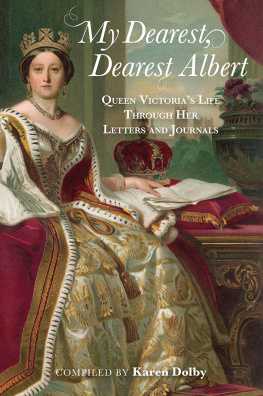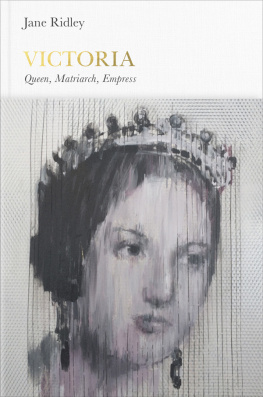EMPRESS

Copyright 2018 Miles Taylor
All rights reserved. This book may not be reproduced in whole or in part, in any form (beyond that copying permitted by Sections 107 and 108 of the U.S. Copyright Law and except by reviewers for the public press) without written permission from the publishers.
For information about this and other Yale University Press publications, please contact:
U.S. Office:
Europe Office:
Set in Adobe Garamond Pro by IDSUK (DataConnection) Ltd
Printed in Great Britain by TJ International Ltd, Padstow, Cornwall
Library of Congress Control Number: 2018944754
ISBN 978-0-300-11809-4 (hbk)
A catalogue record for this book is available from the British Library.
10 9 8 7 6 5 4 3 2 1
For Shalini
CONTENTS
ILLUSTRATIONS
ACKNOWLEDGEMENTS
T his book has evolved over some time and I have received much support and incurred many debts of gratitude along the way. To begin, I must thank my colleagues at the University of York and in the School of Advanced Study at the University of London, who allowed me the time and space to be a historian alongside my day jobs. In this respect I am particularly grateful to my head of department at York, Mark Ormrod and to John Local, the academic co-ordinator for Arts and Humanities, for their kindness and guidance. In London, the vice chancellor, Sir Graeme Davies, and Roger Kain, the dean of the School of Advanced Study, ensured that I had the means to carry on my research for this book. Without Elaine Walters, the unflappable and tireless administrator of the Institute of Historical Research, I could never have combined my own studies with the demands of running the IHR. I will long retain warm memories of the six years spent in her professional company.
I was trained in the early 1980s as a historian of Victorian Britain, albeit one who was encouraged to peer out at the rest of the world in order to bring the metropole into focus. Plotting the interconnections between Empire and the domestic polity in this manner led me ultimately to the monarchy, and then, inevitably, to India. There I was not a complete novice. Peter Marshall introduced me to the history of British India as an undergraduate. At Cambridge in the 1990s I learned much, in different ways, from Susan Bayly and from the late Sir Christopher Bayly. However, in unravelling the full story of Queen Victoria and India, I have entered uncharted territory, encountering only a few stray historians along the way, reliant instead on the expertise of archivists, curators and librarians. I benefited hugely from being given access to the Royal Archives at Windsor. There Pamela Clark, Allison Derrett and Sophie Gordon guided me through the royal correspondence and photographs, accompanied by some splendid baking. Bridget Wright introduced me to the Royal Library. At the Royal Collections in St Jamess Palace, Jonathan Marsden and later Agata Rutkowska expedited my enquiries. Across India good will, luck, persistence and wonderful food sustained my fieldwork. In Delhi, Mushirul Hasan eased my journey into the National Archives of India and helped open doors in Bhopal, Bikaner and Chennai. Also at the National Archives Jaya Ravindran was so welcoming and generous with her time. Elsewhere in India I gained much from many small acts of kindness. I would like to single out the following librarians and curators: Joyoti Roy at the Alkazi Foundation in Delhi, Chittaranjan Panda and Jayanta Sengupta at the Victoria Memorial Hall in Kolkata, Sanam Ali Khan at the Rampur Raza Library (a visit made memorable by taking tea in her ancestral home), Dr J. V. Gayathri at the Mysore District Archives, Sonika Soni and Bhupendra Singh Auwa at the Mewar Palace Archives in Udaipur, Pankaj Sharma and Giles Tillotson at the City Palace Museum in Jaipur, Nagender Reddy at the Salar Jung Museum in Hyderabad, and Ashim Mukhopadhyay at the National Library in Kolkata. Two researchers Saptadeepa Bannerjee in Kolkata and Raghav Kishore in London assisted me in collecting material. Other friends and colleagues shared findings and references or copied correspondence from archives in India, Germany and the USA that I was unable to consult in person: thanks in this regard to Zirwat Chowdury, Dane Kennedy, Prashant Kidambi, Cindy McCreery, Samira Sheikh and A. R. Venkatachalapathy. Horst Gehringer and Oliver Walton guided me in and out of the archives in Coburg and Gotha. Richard Virr at McGill University in Montreal made available vital copies of correspondence, and Russell Lord let me view photographs in the Metropolitan Museum in New York, whilst Roy Ritchie introduced me to the riches of the Huntington Library at Pasadena, and to kumquats. Sandy and Michaela Reid kindly allowed me into their Jedburgh home to consult the archives of their distinguished ancestor. Many hours have been spent in the Asia and Africa Reading Room of the British Library in London, where the staff have been unfailingly diligent and friendly.
For permission to consult and quote from records in their possession, I acknowledge the permission of Her Majesty Queen Elizabeth II; the Royal Commission for the Exhibition of 1851; the British Library; Lambeth Palace Library; The National Archives, Kew; News International; the Royal Society of Arts; the Dean and Chapter of Westminster Abbey; the Deputy Keeper of the Records, Public Record Office of Northern Ireland, and the Marchioness of Dufferin and Ava; the University of Birmingham; the Churchill Archives Centre, Churchill College, Cambridge; Cambridge University Library; the Trustees of the Devonshire Collection, Chatsworth House; Durham University Library; the National Archives of Scotland; the University of Sussex; the Marquess of Salisbury, Hatfield House; Suffolk Record Office; the Library and Museum of Freemasonry; the Bodleian Library, University of Oxford; the West Yorkshire Archives Service; Liverpool Record Office; the Hartley Library, University of Southampton; Hampshire Record Office; the Borthwick Institute for Archives, University of York; McGill University; the Huntington Library, San Marino; Nehru Museum and Memorial Library; Mumbai University Library; Bikaner Palace; the National Archives of India, and the State Archives of Andhra Pradesh, Baroda, Bikaner, Karnataka, Madhya Pradesh, Tamil Nadu, West Bengal and the District Archives of Delhi and Mysore. The publication has been made possible by a grant from the Scouloudi Foundation in association with the Institute of Historical Research.
Early versions of the ideas and arguments that follow were tried out at various seminars, conferences and lectures. For their hospitality, commentary and suggestions on those occasions, the following scholars are due warm thanks: Shigeru Akita, Peter Bang, Asma Ben Hassine, Fabrice Bensimon, Franz Bosbach, Judith Brown, Joya Chatterji, Ariane Chernock, John Cookson, Ian Copland, David Craig, Santanu Das, Rajat Datta, Christiane Eisenberg, Lawrence Goldman, Anindita Ghosh, Peter Gray, Holger Hoock, Duncan Kelly, Harshan Kumarasingham, Colin Kidd, Jrn Leonhard, Claude Markowitz, Philip Murphy, Andrzej Olechnowicz, Jurgen Osterhammel, David Washbrook, Yvonne Ward, Lucy Worsley and Jon Wilson.
I am blessed with a superb publisher. Robert Baldock and Heather McCallum deserve a special mention for their advice and encouragement, and above all for their patience. I am grateful to Marika Lysandrou for her calm efficiency in the final stages and to Christopher Shaw, who did the proofreading. Thanks too to Andy Lawrence at Keele University Digital Images Services who drew the map of British India, Tony Stewart for his linguistic skills and Brendan Bell for applying his magic touch to some of the illustrations.
Next page












